Geospatial Assessment of Ground Water Quality and Associated Health Problems in the Western Region of India
Abstract
:1. Introduction
2. Methodology
2.1. Study Area
2.2. Process and Method
2.3. Water Quality Index Generation for Drinking Purposes
- (1)
- Step 1: Each of the given 12 parameters has been assigned a weight (Wi) according to its relative presence in water for assessing the overall water quality particularly for human consumption (Table 2).
- (2)
- Step 2: By applying the following equation, the relative weight (Wi) has been calculated
- Wi = Relative weight;
- wi = Weight of each parameter;
- n = The number of parameters.
- (3)
- Step 3: Based on the guideline laid down by BIS 10500 (1991), every individual parameter is given a specific value by dividing its concentration in an individual water sample by its corresponding standard designated by BIS, and the obtained results have been multiplied by 100 to generate a quality rating scale (qi)
- qi = Quality rating;
- Ci = Concentration of each chemical parameter in each sample in mg/L;
- Si = The water standard for drinking for each chemical part.
- SIi = Sub index of ith parameter.
2.4. Map Generation
3. Results and Discussion
3.1. Evaluating Water Quality for Drinking Purposes
3.1.1. Levels of Primary Physicochemical Parameters Determining the Overall Quality of Water in the Study Area
- pH Level is an important functional parameter of water quality. The optimum pH level standard requirement should fall within the range of 6.5 to 8.5 [3]. However, as per BIS standards, the upper permissible pH level limit for drinking purposes has been standardized to 8.5 pH value with overall range of 6 to 9. While the villages in the western, southwestern region of Phagi like Nimera and Chauru had pH ranging between 6 to 7, it increases on moving from the southwestern region to Central and Northern regions with villages like Phagi and Renwal, having maximum pH between 8 to 9, which is slightly alkaline in nature. However, the pH values of the region are observed to be within permissible limits of BIS (i.e., between 6 to 9).
- Fluoride (F−): Fluoride is a monatomic anion found naturally in water with the chemical formula F⁻. Fluoride is primarily sourced from water in the human diet. Therefore, much of the difference in total fluoride intake is dependent on the compositional variability of water [47]. The existence of fluoride in groundwater is generally dissolved from geological formation [48]. While excessive intake of fluoride is often associated with dental fluorosis, excessive exposure to fluoride may lead to crippled skeletal fluorosis [49]. However, in the case of fluoride, the excess and deficiency both can be detrimental to human health; therefore, its optimum consumption is essential for balanced growth. The optimal intake of fluoride accepted widely ranges from 0.05 to 0.07 mg/kg of the total body weight [50]. It was observed that the Phagi region has an overall higher concentration of fluoride, which ranged between 1.66 to 8.60 mg/L, and was way above the BSI prescribed standards (fluoride 1.0 mg/L) for drinking water in India. The fluoride concentration was highest in the Central and North Eastern region with more than a 3.90 mg/L concentration. More than 70% of the study area is badly affected by fluoride in drinking water (Figure 4A).
- Total Dissolved Solids (TDS): refers to the overall accumulation of total dissolved mineral compositions in water. The levels of TDS in water depend on many natural, physiological factors, rock structures, rainfall, soil type, etc. as well as human induced factors like mining, increased discharge of solids into the water, water extraction levels, etc. [3]. The study shows higher TDS against the permissible limit of 500 mg/L, allocated by BIS. In fact, except for a few villages in the southern part of the region (Nimera village) which have TDS below 500 mg/L, most of the villages in the Central, Western and Northern part of the Block, show a very high concentration of TDS ranging more than 1500 mg/L. Almost 70% of the region’s water is found “unsuitable for drinking purposes” owing to its high TDS concentrations > 1000 mg/L. High TDS concentration pockets are located along the central, northeastern and southwestern part within the region (Figure 4B).
3.1.2. Water Quality Index (WQI) Analysis
3.2. Water Quality and Disease Prevalence
3.2.1. Fluorosis
3.2.2. Gastroenteritis
4. Conclusions
Author Contributions
Funding
Institutional Review Board Statement
Informed Consent Statement
Data Availability Statement
Acknowledgments
Conflicts of Interest
Abbreviations
| WQI | Water Quality Index |
| GWQI | Groundwater Quality Index |
| IDW | Inverse Distance Weighting. |
| BIS | Bureau of Indian Standards |
| TDS | Total Dissolved Solids |
| pH | Power of Hydrogen |
| IDW | Inverse Distance Weighting |
| PHC | Primary Health Centers |
References
- Asadi, S.S.; Vuppala, P.; Reddy, M.A. Remote Sensing and GIS Techniques for Evaluation of Groundwater Quality in Municipal Corporation of Hyderabad (Zone-V), India. Int. J. Environ. Res. Public Health 2007, 4, 45–52. [Google Scholar] [CrossRef] [Green Version]
- Subbarao, C.; Subbarao, N.V.; Priyadarsini, J.P.; Nair, A.V. Assessment of Groundwater Quality in the Urban Aquifers of Visakhapatnam. J. Appl. Hydrol. 1997, 10, 60–70. [Google Scholar]
- Singha, S.S.; Devatha, C.P.; Singha, D.S.; Verma, M.K. Assessing Ground Water Quality using GIS. Int. J. Eng. Res. 2015, 4. [Google Scholar] [CrossRef]
- Fleisher, J.M.; Jones, F.; Kay, D.; Stanwell-Smith, R.; Wyer, M.; Morano, R. Water and Non-Water-Related Risk Factors for Gastroenteritis among Bathers Exposed to Sewage-Contaminated Marine Waters. Int. J. Epidemiol. 1993, 22, 698–708. [Google Scholar] [CrossRef]
- Garg, N.K.; Hassan, Q. Alarming Scarcity of Water in India. Curr. Sci. 2007, 93, 932–941. [Google Scholar]
- Faure, G. Principles and Applications of Geochemistry: A Comprehensive Textbook for Geology Students; Prentice Hall: Upper Saddle River, NJ, USA, 1997. [Google Scholar]
- Stallard, R.; Edmond, J.M. Geochemistry of the Amazon: 2. The Influence of Geology and Weathering Environment on the Dissolved Load. J. Geophys. Res. Earth Surf. 1983, 88, 9671–9688. [Google Scholar] [CrossRef]
- Umar, R.; Absar, A. Chemical Characteristics of Groundwater in Parts of the Gambhir River Basin, Bharatpur District, Rajasthan, India. Environ. Earth Sci. 2003, 44, 535–544. [Google Scholar] [CrossRef]
- Surinaidu, L.; Nandan, M.; Sahadevan, D.; Umamaheswari, A.; Tiwari, V. Source Identification and Management of Perennial Contaminated Groundwater Seepage in the Highly Industrial Watershed, South India. Environ. Pollut. 2021, 269, 116165. [Google Scholar] [CrossRef]
- Mahmood, A.; Kundu, A. India’s Demography in 2050: Size, Structure and Habitat. In Proceedings of the IWMI-TATA Partners Meet-2005, Anand, India, 24–26 February 2005. [Google Scholar]
- Phansalkar, S.J.; Kher, P.; Deshpande, P. Expanding Rings of Dryness: Water Imports from Hinterlands to Cities and the Rising Demands of Mega-Cities. In Proceedings of the IWMI-Tata Annual Partner’s Meet, Anand, India, 24–26 February 2005. [Google Scholar]
- Government of India Report. National Compilation on Dynamic Ground Water Resources of India, 2017; Ministry of Jal Shakti, Department of Water Resources, RD & GR Central Ground Water Board Faridabad: Faridabad, India, 2019.
- Ducci, D. GIS Techniques for Mapping Groundwater Contamination Risk. Nat. Hazards 1999, 20, 279–294. [Google Scholar] [CrossRef]
- Olajire, A.A.; Imeokparia, F.E. Water Quality Assessment of Osun River: Studies on Inorganic Nutrients. Environ. Monit. Assess. 2001, 69, 17–28. [Google Scholar] [CrossRef]
- Kumar, M.D.; Tortajada, C. Health Impacts of Water Pollution and Contamination. In Impact of Urbanization on Water Shortage in Face of Climatic Aberrations; Springer: Singapore, 2020; pp. 23–30. [Google Scholar]
- Falkenberg, T.; Saxena, D.; Kistemann, T. Impact of Wastewater-Irrigation on in-Household Water Contamination. A Cohort Study among Urban Farmers in Ahmedabad, India. Sci. Total. Environ. 2018, 639, 988–996. [Google Scholar] [CrossRef]
- Ali, S.A.; Ahmad, A. Analysing Water-Borne Diseases Susceptibility in Kolkata Municipal Corporation Using WQI and GIS Based Kriging Interpolation. Geo J. 2020, 85, 1151–1174. [Google Scholar] [CrossRef]
- Schneider, K. Groundwater Scarcity, Pollution Set India on Perilous Course. Circle of Blue. Available online: https://www.circleofblue.org/2018/world/groundwater-scarcity-pollution-set-india-on-perilous-course/ (accessed on 27 October 2020).
- Alssgeer, H.M.A.; Gasim, M.B.; Hanafiah, M.M.; Abdulhadi, E.R.A.; Azid, A. GIS-Based Analysis of Water Quality Deterioration in the Nerus River, Kuala Terengganu Malaysia. Desalinzation Water Treat. 2018, 112, 334–343. [Google Scholar] [CrossRef] [Green Version]
- Venkateswaran, S.; Deepa, S. Assessment of Groundwater Quality Using GIS Techniques in Vaniyar Watershed, Ponnaiyar River, Tamil Nadu. Aquat. Proc. 2015, 4, 1283–1290. [Google Scholar] [CrossRef]
- Zeilhofer, P.; Zeilhofer, L.V.A.C.; Hardoim, E.L.; De Lima, Z.M.; Oliveira, C.S. GIS Applications for Mapping and Spatial Modeling of Urban-Use Water Quality: A Case Study in District of Cuiabá, Mato Grosso, Brazil. Cad. Saúde Pública 2007, 23, 875–884. [Google Scholar] [CrossRef] [PubMed] [Green Version]
- Longley, P.A.; Goodchild, M.F.; Maguire, D.J.; Rhind, D.W. Geographic Information Systems and Science; John Wiley and Sons: Hoboken, NJ, USA, 2005. [Google Scholar]
- Bidhuri, S.; Jain, P. Identifying Waterborne Disease Prone Areas Using Geospatial Approach Along the Right Bank of Yamuna River in Delhi. Int. J. Environ. Health Res. 2019, 29, 561–581. [Google Scholar] [CrossRef] [PubMed]
- Mishra, V.C. Geography of Rajasthan; National Book Trust: New Delhi, India, 1967. [Google Scholar]
- Bhakar, P.; Singh, A.P. Groundwater Quality Assessment in a Hyper-arid Region of Rajasthan, India. Nonrenew. Resour. 2019, 28, 505–522. [Google Scholar] [CrossRef]
- Agrawal, R. Study of Physico-Chemical Parameters of Groundwater Quality of Dudu Town in Rajasthan. Rasayan J. Chem. 2009, 2, 969–971. [Google Scholar]
- Durfor, C.N.; Becker, E. Public Water Supplies of the 100 Largest Cities of the United States, 1962; US Government Printing Office: Washington, DC, USA, 1964.
- Tirkey, P.; Bhattacharya, T.; Chakraborty, S.; Baraik, S. Assessment of Groundwater Quality and Associated Health Risks: A Case Study of Ranchi City, Jharkhand, India. Groundw. Sustain. Dev. 2017, 5, 85–100. [Google Scholar] [CrossRef]
- BIS 10500; Indian Standard Drinking Water Specifications IS 10500: 1991, Edition 2.2, 2003–2009. BIS (Bureau of Indian Standards): New Delhi, India, 2003; p. 18.
- Bouslah, S.; Lakhdar, D.; Larbi, H. Water Quality Index Assessment of Koudiat Medouar Reservoir, Northeast Algeria Using Weighted Arithmetic Index Method. J. Water Land Dev. 2017, 35, 221–228. [Google Scholar] [CrossRef]
- Prasad, B.; Rao, P.R.; Tigga, A. Groundwater Quality Assessment Using the Weighted Arithmetic Index Method in the Selected Villages of Butchayyapeta Mandal, Visakhapatnam, Andhra Pradesh, India. Environ. Monit. Assess. 2021, 193, 1–17. [Google Scholar] [CrossRef]
- Chandra, D.S.; Asadi, S.S.; Raju, M.V.S. Estimation of Water Quality Index by Weighted Arithmetic Water Quality Index Method: A Model Study. Int. J. Civ. Eng. Technol. 2017, 8, 1215–1222. [Google Scholar]
- Swaine, S.; Schneider, P.J. The Chemistry of Surface Water in Prairie Ponds. Am. Chem. Soc. Adv. Chem. Ser. 1971, 106, 99–104. [Google Scholar]
- Frape, S.; Fritz, P.; McNutt, R. Water-Rock Interaction and Chemistry of Groundwaters from the Canadian Shield. Geochim. Cosmochim. Acta 1984, 48, 1617–1627. [Google Scholar] [CrossRef]
- Raju, K.C.B. Importance of Recharging Depleted Aquifers: State of the Art of Artificial Recharge in India. J. Geol. Soc. India 1998, 51, 429–454. [Google Scholar]
- Stumm, W.; Morgan, J.J. Aquatic Chemistry: Chemical Equilibria and Rates in Natural Waters, 3rd ed.; John Wiley and Sons: Hoboken, NJ, USA, 2012; Volume 126. [Google Scholar]
- Wicks, C.M.; Herman, J.S. The Effect of a Confining Unit on the Geochemical Evolution of Ground Water in the Upper Floridan Aquifer System. J. Hydrol. 1994, 153, 139–155. [Google Scholar] [CrossRef]
- Machiwal, D.; Jha, M.K.; Mal, B.C. GIS-based Assessment and Characterization of Groundwater Quality in a Hard-Rock Hilly Terrain of Western India. Environ. Monit. Assess. 2011, 174, 645–663. [Google Scholar] [CrossRef] [PubMed]
- Bartier, P.M.; Keller, C. Multivariate Interpolation to Incorporate Thematic Surface Data Using Inverse Distance Weighting (IDW). Comput. Geosci. 1996, 22, 795–799. [Google Scholar] [CrossRef]
- Mueller, T.G.; Pusuluri, N.B.; Mathias, K.K.; Cornelius, P.L.; Barnhisel, R.I.; Shearer, S.A. Map Quality for Ordinary Kriging and Inverse Distance Weighted Interpolation. Soil Sci. Soc. Am. J. 2004, 68, 2042–2047. [Google Scholar] [CrossRef]
- Lad, D.; Mehta, M.; Vashi, M. Assessment of Surface Water Quality Using GIS: Case of Tapi Basin, Surat, Gujarat, India. In Proceedings of FORM 2021; Springer: Singapore, 2019; pp. 303–311. [Google Scholar]
- Huchhe, M.R.; Bandela, N.N. Study of Water Quality Parameter Assessment Using GIS and Remote Sensing in DR. B.A.M University, Aurangabad, MS. Int. J. Latest Technol. Eng. Manag. Appl. Sci. 2016, 5, 46–50. [Google Scholar]
- Cude, C.G. Oregon Water Quality Index a Tool for Evaluating Water Quality Management Effectiveness. J. Am. Water Resour. Assoc. 2001, 37, 125–137. [Google Scholar] [CrossRef]
- Srinivasamoorthy, K.; Nanthakumar, C.; Vasanthavigar, M.; Vijayaraghavan, K.; Rajivgandhi, R.; Chidambaram, S.; Anandhan, P.; Manivannan, R.; Vasudevan, S. Groundwater Quality Assessment from a Hard Rock Terrain, Salem district of Tamilnadu, India. Arab. J. Geosci. 2011, 4, 91–102. [Google Scholar] [CrossRef]
- Herojeet, R.; Rishi, M.S.; Lata, R.; Sharma, R. Application of Environmetrics Statistical Models and Water Quality Index for Groundwater Quality Characterization of Alluvial Aquifer of Nalagarh Valley, Himachal Pradesh, India. Sustain. Water Resour. Manag. 2016, 2, 39–53. [Google Scholar] [CrossRef] [Green Version]
- Ramakrishnaiah, C.R.; Sadashivaiah, C.; Ranganna, G. Assessment of Water Quality Index for the Groundwater in Tumkur Taluk, Karnataka State, India. E-J. Chem. 2009, 6, 523–530. [Google Scholar] [CrossRef] [Green Version]
- Aoun, A.; Darwiche, F.; Al Hayek, S.; Doumit, J. The Fluoride Debate: The Pros and Cons of Fluoridation. Prev. Nutr. Food Sci. 2018, 23, 171–180. [Google Scholar] [CrossRef] [PubMed]
- Kusuma, S. Assesment and Mapping of Ground Water Quality Using Geographical Information Systems. Int. J. Eng. Sci. Technol. 2010, 2, 6035–6046. [Google Scholar]
- Grandjean, A.; Bartram, J. Essential Nature of Water for Health: Water as Part of the Dietary Intake for Nutrients and the Role of Water in Hygiene. In Encyclopedia of Environmental Health; Elsevier: Amsterdam, The Netherlands, 2011; pp. 594–604. [Google Scholar]
- Warren, J.J.; Levy, S.M.; Broffitt, B.; Cavanaugh, J.E.; Kanellis, M.J.; Weber-Gasparoni, K. Considerations on Optimal Fluoride Intake Using Dental Fluorosis and Dental Caries Outcomes-A Longitudinal Study. J. Public Health Dent. 2009, 69, 111–115. [Google Scholar] [CrossRef] [Green Version]
- Karanis, P. Giardia and Cryptosporidium: Occurrence in Water Supplies. In Encyclopedia of Environmental Health; Elsevier BV: Amsterdam, The Netherlands, 2011; pp. 946–954. [Google Scholar]
- Pal, M.; Ayele, Y.; Hadush, A.; Panigrahi, S.; Jadhav, V.J. Public Health Hazards Due to Unsafe Drinking Water. Air Water Borne Dis. 2018, 7, 1–6. [Google Scholar] [CrossRef]
- Gall, A.M.; Mariñas, B.J.; Lu, Y.; Shisler, J.L. Waterborne Viruses: A Barrier to Safe Drinking Water. PLoS Pathog. 2015, 11, e1004867. [Google Scholar] [CrossRef]
- Bain, R.; Cronk, R.; Hossain, R.; Bonjour, S.; Onda, K.; Wright, J.; Yang, H.; Slaymaker, T.; Hunter, P.; Prüss-Ustün, A.; et al. Global Assessment of Exposure to Faecal Contamination through Drinking Water Based on a Systematic Review. Trop. Med. Int. Health 2014, 19, 917–927. [Google Scholar] [CrossRef] [Green Version]
- Suthar, S.; Garg, V.K.; Jangir, S.; Kaur, S.; Goswami, N.; Singh, S. Fluoride contamination in drinking water in rural habitations of Northern Rajasthan, India. Environ. Monitor. Assess. 2008, 145, 1–6. [Google Scholar] [CrossRef]
- Den Besten, P.; Li, W. Chronic Fluoride Toxicity: Dental Fluorosis. Oral Biofilms 2011, 22, 81–96. [Google Scholar] [CrossRef] [Green Version]
- WHO, Geneva, Water-Related Diseases—Fluorosis. 1999. Available online: https://www.who.int/teams/maternal-newborn-child-adolescent-health-and-ageing/maternal-health/about/water-sanitation-and-health (accessed on 15 September 2021).
- Cotruvo, J.A. 2017 WHO Guidelines for Drinking Water Quality: First Addendum to the Fourth Edition. J.-Am. Water Work. Assoc. 2017, 109, 44–51. [Google Scholar] [CrossRef] [Green Version]
- Susheela, A.K.; Toteja, G. Prevention & Control of Fluorosis & Linked Disorders: Developments in the 21st Century-Reaching Out to Patients in the Community & Hospital Settings for Recovery. Indian J. Med Res. 2018, 148, 539–547. [Google Scholar] [CrossRef]
- Susheela, A.K. Fluorosis and Iodine Deficiency Disorders in India. Curr. Sci. 2018, 115, 860–867. [Google Scholar] [CrossRef]
- Pneumonia and Diarrhoea: Tackling the Deadliest Diseases for the World’s Poorest Children; UNICEF: New York, NY, USA, 2012.
- Jain, P.; Jain, A. Waterborne Viral Gastroenteritis: An Introduction to Common Agents. In Water and Health; Springer: New Delhi, India, 2014; pp. 53–74. [Google Scholar]
- Häfliger, D.; Hübner, P.; Lüthy, J. Outbreak of Viral Gastroenteritis due to Sewage-Contaminated Drinking Water. Int. J. Food Microbiol. 2000, 54, 123–126. [Google Scholar] [CrossRef]
- Kukkula, M.; Arstila, P.; Klossner, M.-L.; Maunula, L.; Bonsdorff, C.-H.V.; Jaatinen, P. Waterborne Outbreak of Viral Gastroenteritis. Scand. J. Infect. Dis. 1997, 29, 415–418. [Google Scholar] [CrossRef] [PubMed]
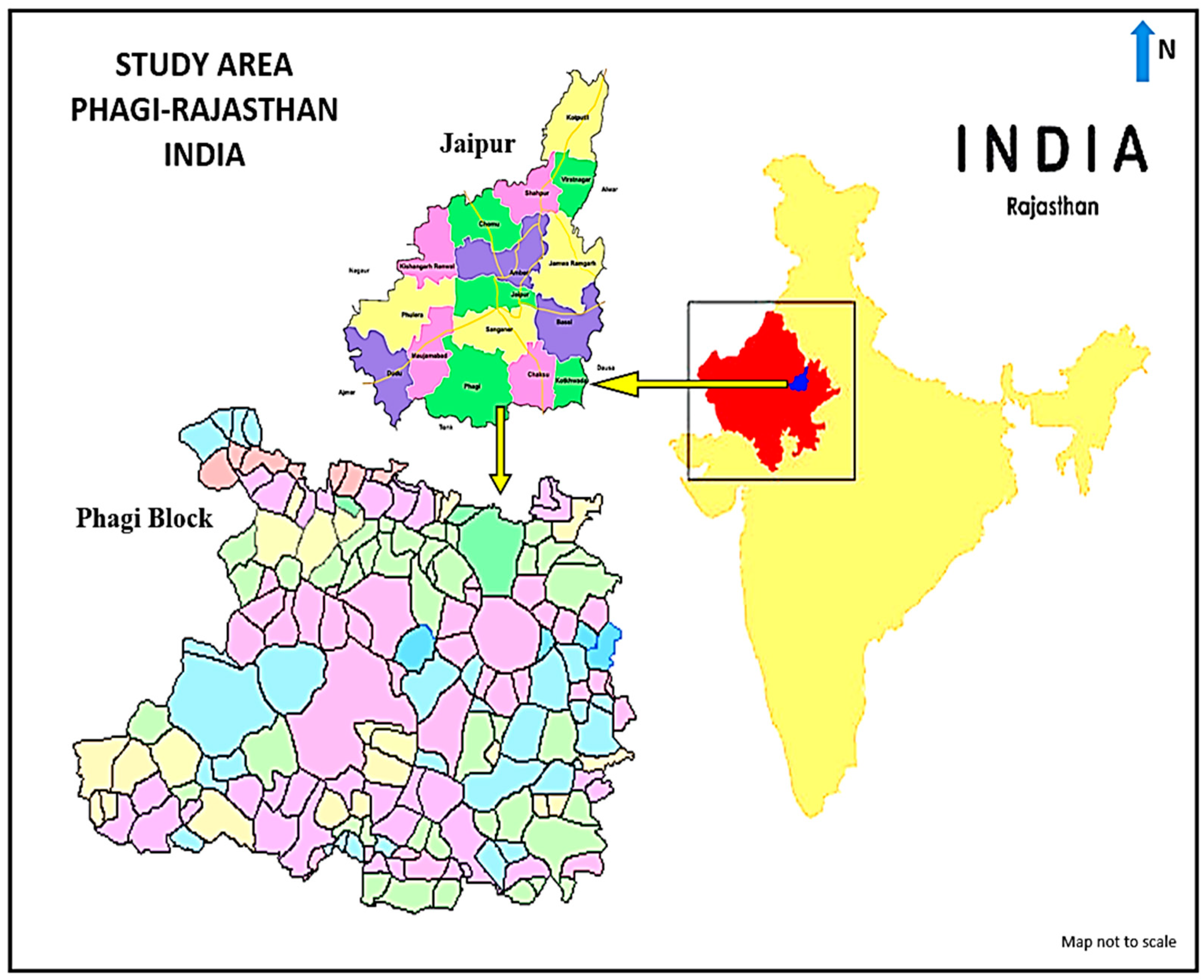
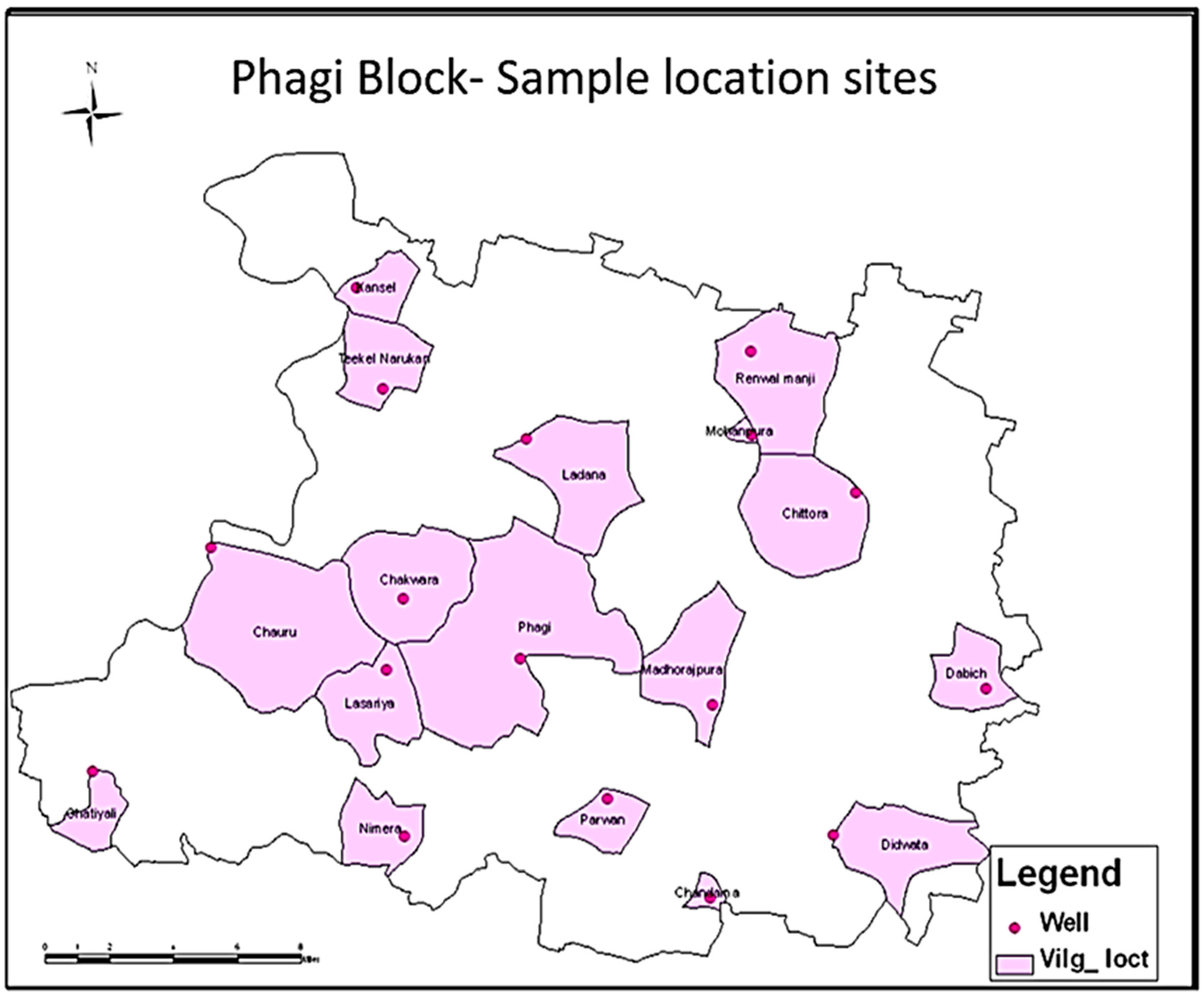
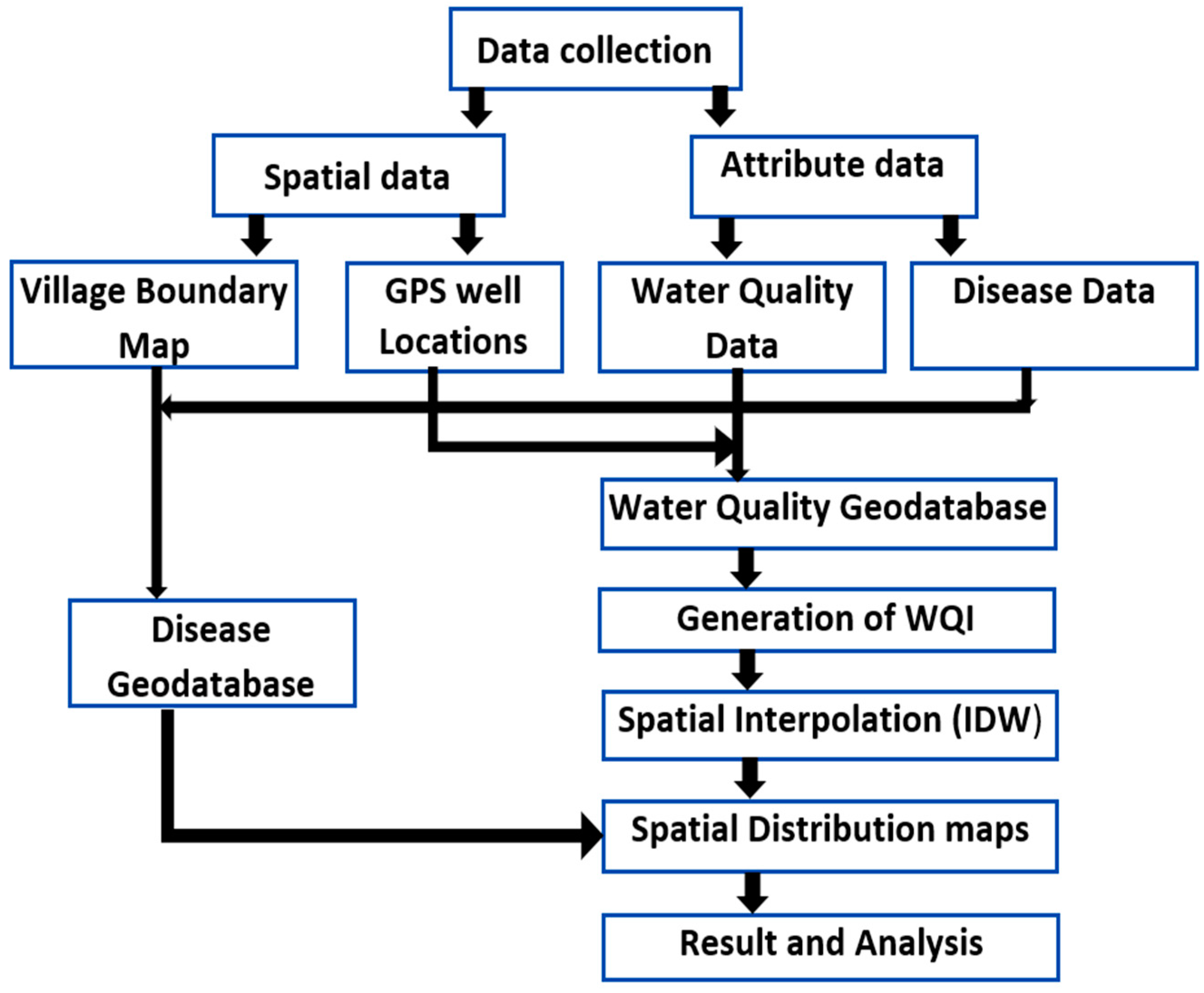

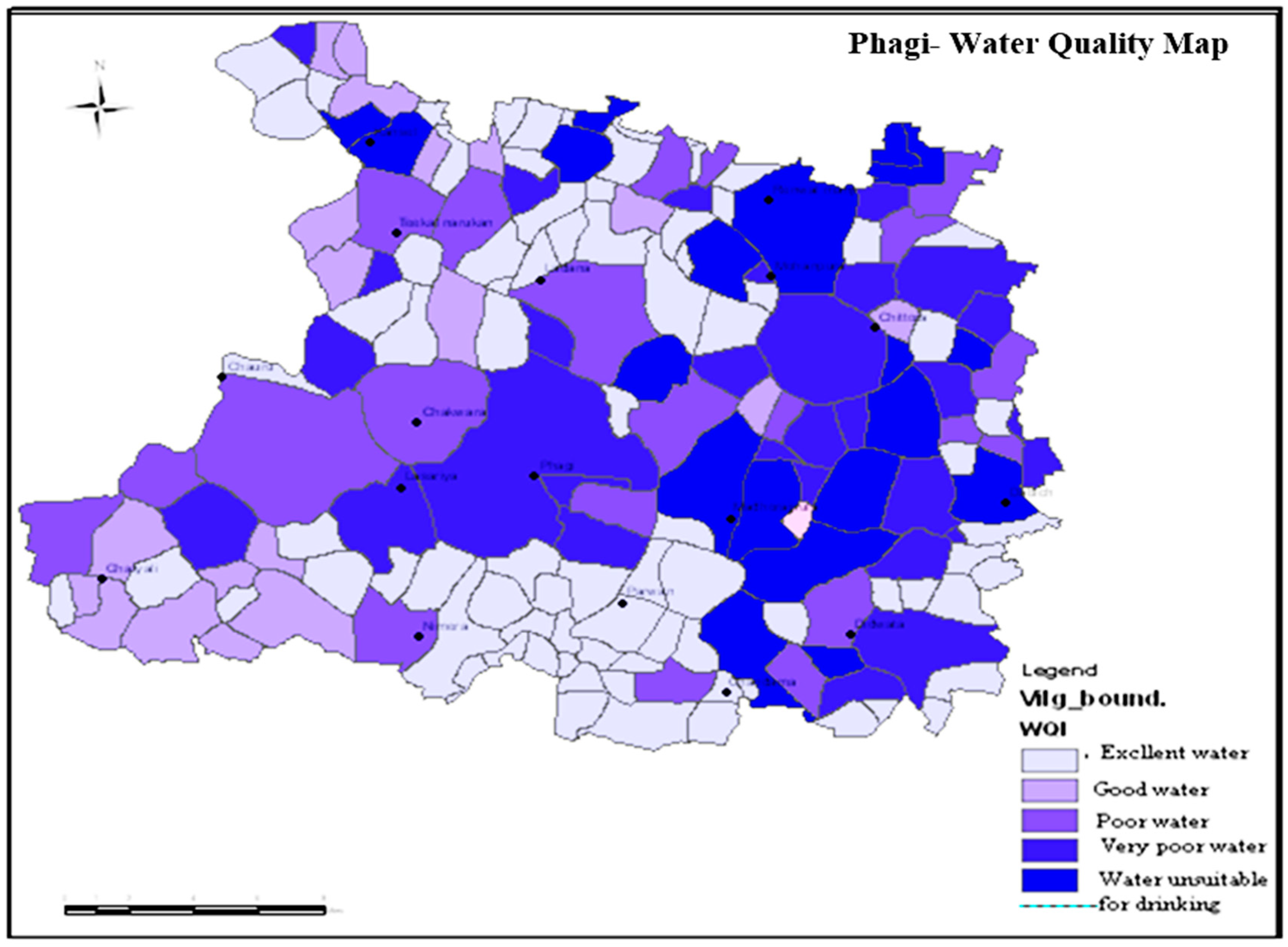
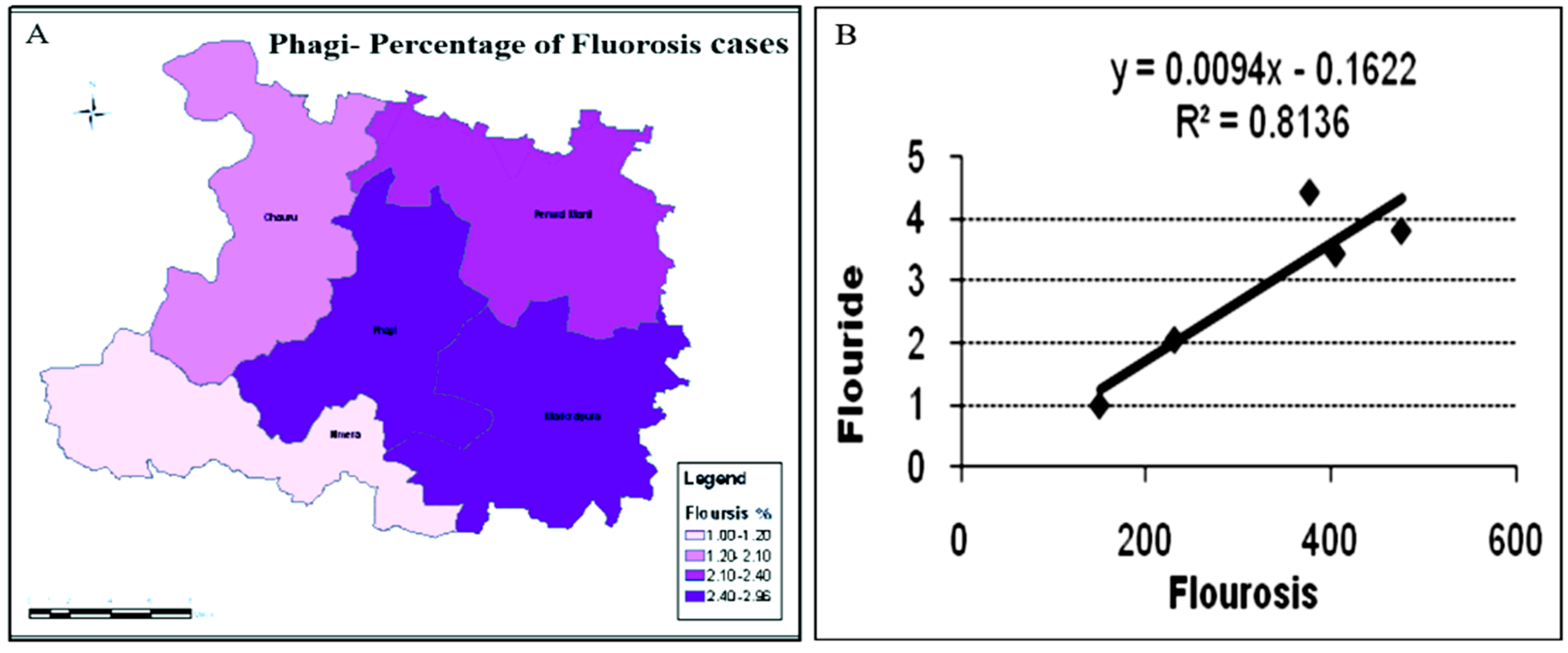
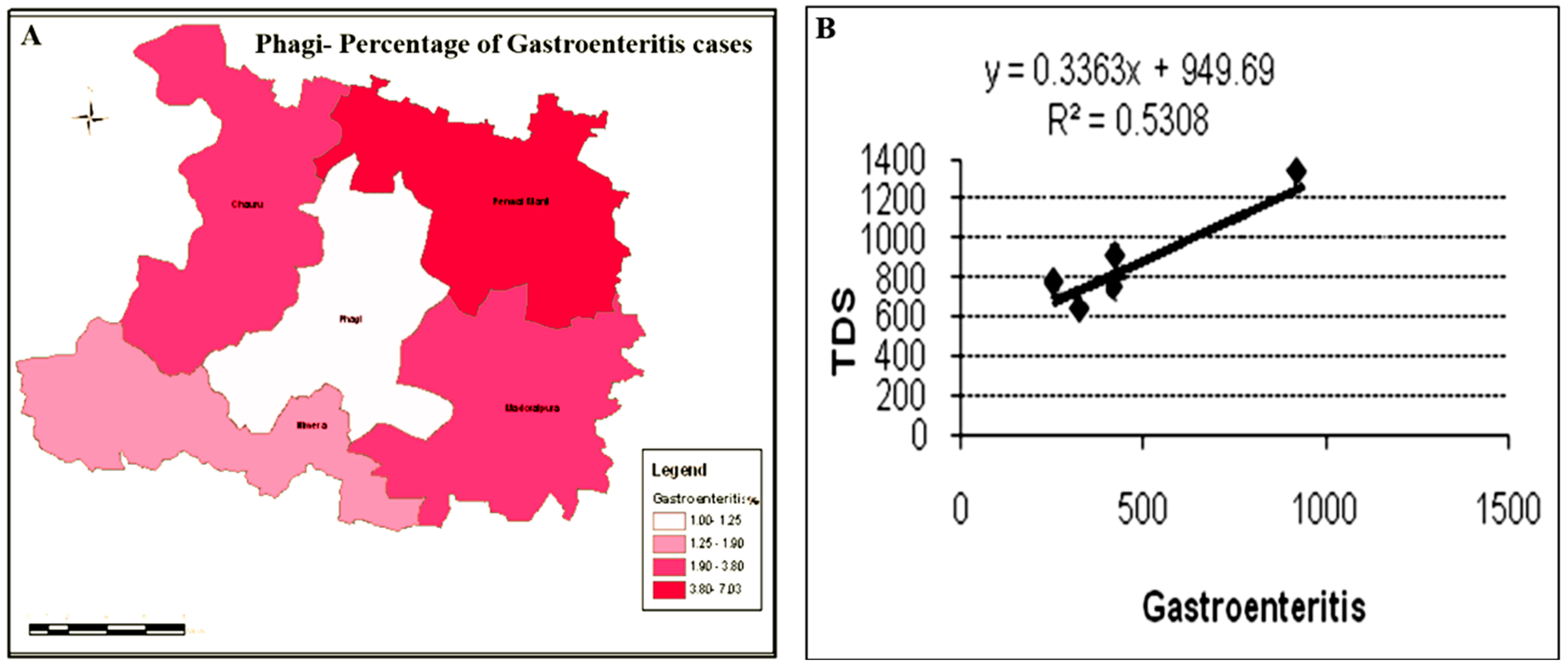
| Chemical Parameter (mg/L) | Indian Standard (BIS10500/1991) |
|---|---|
| TDS | 500 |
| pH | 6.5 |
| Bicarbonate | - |
| Phosphate | - |
| Sodium | 200 |
| Calcium | 75 |
| Nitrate | 45 |
| Fluoride | 1.0 |
| Chloride | 200 |
| Total hardness | 200 |
| Sulphate | - |
| Potassium | - |
| Chemical Parameter (mg/L) | Indian Standard (BIS10500/1991) | Weight (wi) | Relative Weight (Wi) |
|---|---|---|---|
| TDS | 500 | 5 | 0.117 |
| pH | 6.5 | 4 | 0.097 |
| Bicarbonate | - | 1 | 0.023 |
| Phosphate | - | 1 | 0.023 |
| Sodium | 200 | 5 | 0.117 |
| Calcium | 75 | 5 | 0.097 |
| Nitrate | 45 | 2 | 0.047 |
| Fluoride | 1.0 | 5 | 0.117 |
| Chloride | 200 | 4 | 0.121 |
| Total hardness | 200 | 4 | 0.121 |
| Sulphate | - | 1 | 0.023 |
| Potassium | - | 4 | 0.033 |
| ∑wi = 41 | ∑Wi = 0.936 |
| S.NO | Water Quality Index | Water Quality |
|---|---|---|
| 1 | 0–100 | Excellent |
| 2 | 100–200 | Good |
| 3 | 200–300 | Poor |
| 4 | 300–400 | Very poor |
| 5 | >400 | Unsuitable for drinking |
| PHC | Chemical Concentration | Percentage of Cases with Disease Incidences 2018–2019 | ||
|---|---|---|---|---|
| Fluoride | TDS | Fluorosis | Gastroenteritis | |
| Phagi | 3.38 | 2034 | 3.87 | 2.98 |
| Madhorajpura | 1.48 | 2175 | 3.09 | 4.52 |
| Chauru | 1.90 | 1897 | 1.99 | 4.85 |
| Renwal | 2.7 | 3134 | 3.50 | 10.03 |
| Nimera | 1.4 | 1905 | 1.50 | 2.80 |
Publisher’s Note: MDPI stays neutral with regard to jurisdictional claims in published maps and institutional affiliations. |
© 2022 by the authors. Licensee MDPI, Basel, Switzerland. This article is an open access article distributed under the terms and conditions of the Creative Commons Attribution (CC BY) license (https://creativecommons.org/licenses/by/4.0/).
Share and Cite
Singh, R.; Upreti, P.; Allemailem, K.S.; Almatroudi, A.; Rahmani, A.H.; Albalawi, G.M. Geospatial Assessment of Ground Water Quality and Associated Health Problems in the Western Region of India. Water 2022, 14, 296. https://doi.org/10.3390/w14030296
Singh R, Upreti P, Allemailem KS, Almatroudi A, Rahmani AH, Albalawi GM. Geospatial Assessment of Ground Water Quality and Associated Health Problems in the Western Region of India. Water. 2022; 14(3):296. https://doi.org/10.3390/w14030296
Chicago/Turabian StyleSingh, Rani, Pallavi Upreti, Khaled S. Allemailem, Ahmad Almatroudi, Arshad Husain Rahmani, and Ghadah M. Albalawi. 2022. "Geospatial Assessment of Ground Water Quality and Associated Health Problems in the Western Region of India" Water 14, no. 3: 296. https://doi.org/10.3390/w14030296
APA StyleSingh, R., Upreti, P., Allemailem, K. S., Almatroudi, A., Rahmani, A. H., & Albalawi, G. M. (2022). Geospatial Assessment of Ground Water Quality and Associated Health Problems in the Western Region of India. Water, 14(3), 296. https://doi.org/10.3390/w14030296







